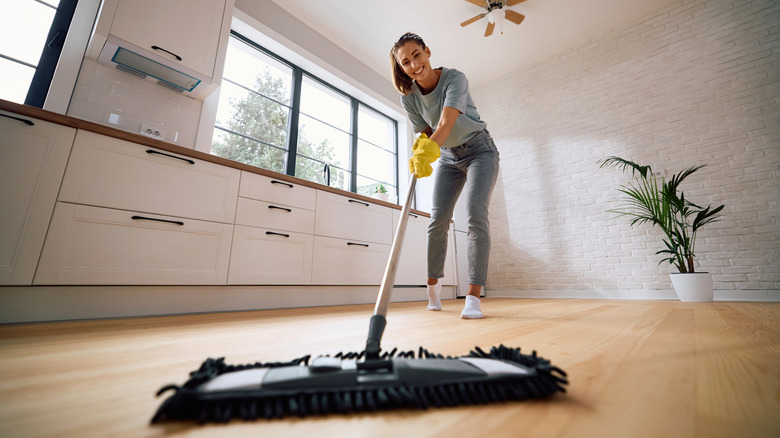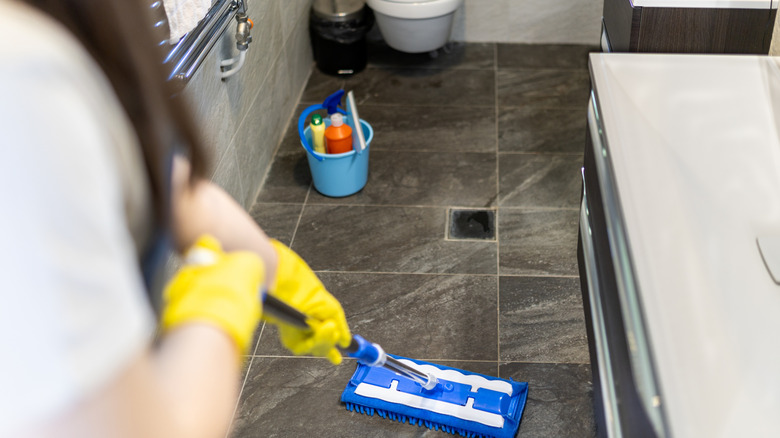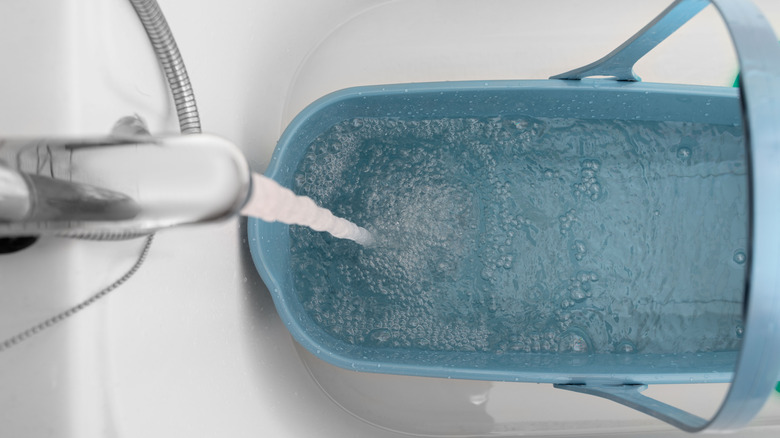You May Be Mopping Your Floors Completely Wrong And Here's Why
Mopping might seem pretty straightforward, but it turns out you might be mopping your floors incorrectly. Choosing the incorrect water temperature is a common mistake a lot of us make when cleaning various floor types. Some flooring materials are best suited to cold water, while others require hot water, and the wrong temperature can lead to ineffective cleaning, especially with floors stained with grease and grime. In some situations, the temperature mismatch may even damage the flooring materials.
While some cleaning solutions might specify which temperature to use, not all do. And typically, if you're mopping with water or natural ingredients, you might just automatically choose cold. Perhaps you can't wait for the water to warm up, or you simply don't give it a second thought. Most homeowners simply grab a bucket, fill it with water, and start mopping, without a thought to what temperature they're using.
Well, you should know that both hot and cold water have their varying advantages in cleaning. Hot water is frequently associated with sanitation, and for good reason. The secret lies in the heated water's kinetic energy, which is higher than that of cold water. This means the molecules in hot water move faster. The increased energy helps the surfactant, an element in your cleaning detergent, break down the dirt or grime faster, so you can remove it from the surface quicker. Because cold water has less kinetic energy, the cleaning process can be slower. However, if you want to clean every floor in your home without causing damage, cold water is usually safer to use for most flooring types than hot water.
When to use hot water when mopping
Water that's too hot can damage certain floor types more compared to when you clean with cold water, so matching it to the right floor type is important. Ensure to check the manufacturer's information for your flooring to determine if hot water is safe to use, as it could damage or loosen some floors' adhesive. Generally, you should be cautious when using hot water on tiles with new or sensitive grout lines, natural stone floors, wood flooring, and laminate. However, most cleaning experts agree that hot water is fine on ceramic or porcelain tiles, which is why it's often recommended in the bathroom or kitchen to thoroughly kill germs. Vinyl floors can also be cleaned with hot water, although warm water is preferred.
You can also use hot water when your cleaning product calls for it or if you have a large, greasy mess, as long as your floor type won't be damaged by it. However, don't confuse hot water with cleaning with boiling water. Using water that's at boiling temperature can actually make a mess worse as the grime softens and easily spreads. You equally increase the risk of burning yourself, so always proceed with the utmost caution.
When cold water is better in mopping
Cold water is typically safe for mopping nearly any floor type, including laminate, wood, vinyl, and tile. When mopping any wood flooring, cold water is best for preventing heat damage. Cold water won't damage the floor's finish or cause warping like exposure to hot water may. If your tile or flooring features an adhesive, using cold water won't soften it like hot water can. The same goes for mopping newly-sealed grouted tiles, as the cold water is more gentle to ensure the grout sealer lasts.
When cleaning floors with seals or finishes, cold water is ideal. Using warm to hot water may leave the finish looking dull and streaky. If you have waxed floors, cold water is always best to avoid stripping the wax from the surface. Some floor cleaners may even specify using only cold water to offer thorough cleaning while remaining gentle on your floor. However, for floors that are hot-water safe, cold water is best for day-to-day cleaning, not extensive ones.
However, no matter what temperature of water you choose, be mindful of how much water you use on the floor. In flooring made of wood and laminate, using excessive water is a harmful mistake when mopping. Too much moisture in these flooring materials can cause permanent damage, including bubbling, warping, or swelling. When cleaning, run a damp, not soaked mop, over the surface, then dry to remove any lingering droplets.


